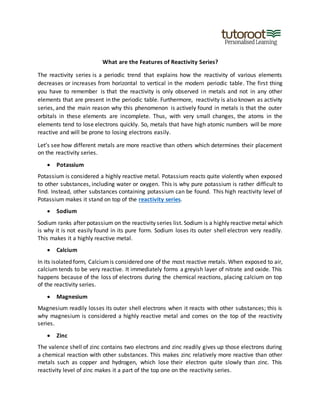
What are the Features of Reactivity Series?
- 1. What are the Features of Reactivity Series? The reactivity series is a periodic trend that explains how the reactivity of various elements decreases or increases from horizontal to vertical in the modern periodic table. The first thing you have to remember is that the reactivity is only observed in metals and not in any other elements that are present in the periodic table. Furthermore, reactivity is also known as activity series, and the main reason why this phenomenon is actively found in metals is that the outer orbitals in these elements are incomplete. Thus, with very small changes, the atoms in the elements tend to lose electrons quickly. So, metals that have high atomic numbers will be more reactive and will be prone to losing electrons easily. Let’s see how different metals are more reactive than others which determines their placement on the reactivity series. Potassium Potassium is considered a highly reactive metal. Potassium reacts quite violently when exposed to other substances, including water or oxygen. This is why pure potassium is rather difficult to find. Instead, other substances containing potassium can be found. This high reactivity level of Potassium makes it stand on top of the reactivity series. Sodium Sodium ranks after potassium on the reactivity series list. Sodium is a highly reactive metal which is why it is not easily found in its pure form. Sodium loses its outer shell electron very readily. This makes it a highly reactive metal. Calcium In its isolated form, Calciumis considered one of the most reactive metals. When exposed to air, calcium tends to be very reactive. It immediately forms a greyish layer of nitrate and oxide. This happens because of the loss of electrons during the chemical reactions, placing calcium on top of the reactivity series. Magnesium Magnesium readily losses its outer shell electrons when it reacts with other substances; this is why magnesium is considered a highly reactive metal and comes on the top of the reactivity series. Zinc The valence shell of zinc contains two electrons and zinc readily gives up those electrons during a chemical reaction with other substances. This makes zinc relatively more reactive than other metals such as copper and hydrogen, which lose their electron quite slowly than zinc. This reactivity level of zinc makes it a part of the top one on the reactivity series.
- 2. Iron Iron is considered an ordinarily reactive metal. In some situations, iron is highly reactive. For instance, when iron reacts with acids. Whereas in general, iron is relatively less reactive in comparison to sodium and potassium. In this way, iron comes on a rather middle area on the reactivity series. Hydrogen Although hydrogen has a single electron in its valence shell, it readily loses its electron during a chemical reaction with other substances. In this way, hydrogen is considered relatively more reactive in some conditions and somewhat less in others. For instance, when hydrogen is left to react with oxygen, it readily loses its valence shell electron. Copper Copper does not lose its electron readily upon reaction with the other compounds; hence it is not considered a highly reactive metal. Based on this relatively less reactive nature, copper is placed below some metals, including iron and hydrogen, on the list of reactivity series. Silver Silver is quite a less reactive metal because it tends to not lose its electron when exposed to air or water. This is why the reactivity level of silver is quite low. On the list of reactivity series, silver comes on quite a lower level because it is taken in the group of least reactive elements. Gold Gold is considered a least reactive metal of all. It does not react readily in any given condition, whether with oxygen, water or acid. Gold comes last on the list of reactivity series because of being the least reactive. Features of Reactivity Series Now that we have understood what reactivity series is? Let us now focus on learning the various features of the reactivity series. In present metals at the top of the reactivity series, high electro-positivity is observed, which decreases when going down the series. Along with this, the electron-donating capacity of metals down this series also decreases. Besides this, the most reactive metals in the series have the unique property of eliminating less reactive elements from their own salts. For instance, the top metals on the list can easily remove the low metals in the series from their salts. Moreover, when we go down the metal reactivity series, we can also find out that the unique property of elements that allow them to separate hydrogen from the hydrides decreases. Furthermore, when metals from the reactivity series come into contact with sulfuric acid or HCL, Besides, if you have any trouble understanding certain concepts of Chemistry, or any other subjects, then it would be a good idea for you to join online interactive classes offered by Tutoroot. It is budget-friendly with many benefits, check it out today.
